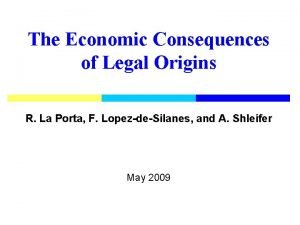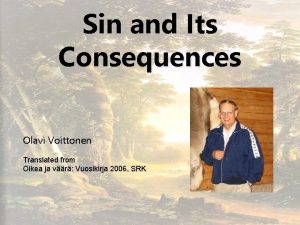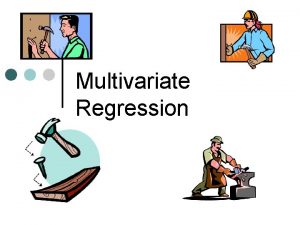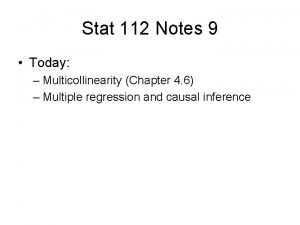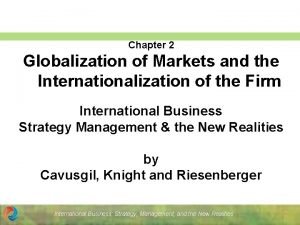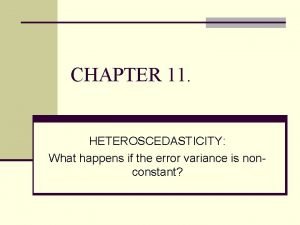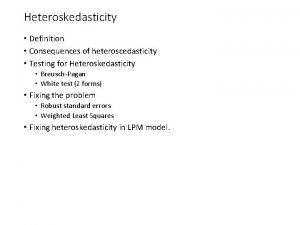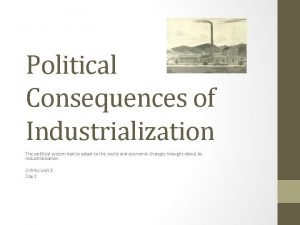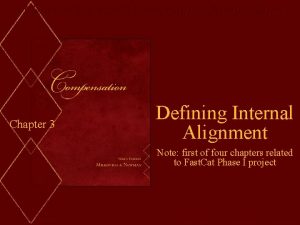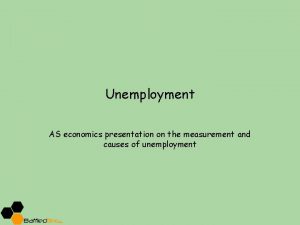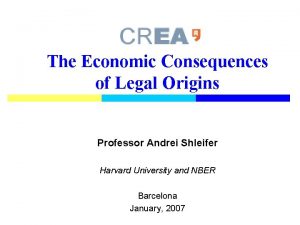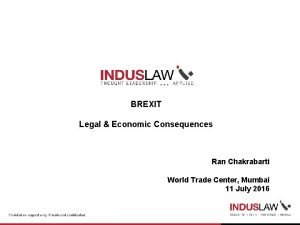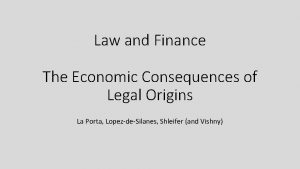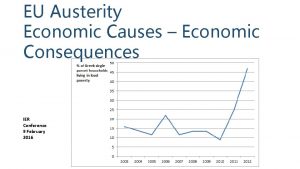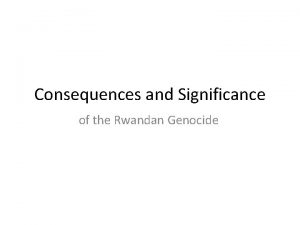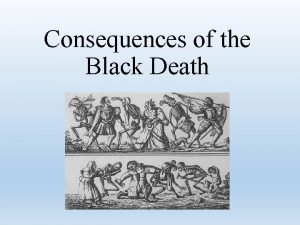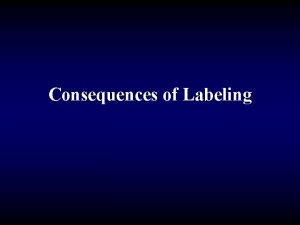The Economic Consequences of Legal Origins R La













































- Slides: 45

The Economic Consequences of Legal Origins R. La Porta, F. Lopez-de-Silanes, and A. Shleifer May 2009

LLSV (1997 -98) and further Contributions 1) Legal rules of investor protection can be measured and coded across countries using national commercial (primarily corporate and bankruptcy) laws. • Coding showed some countries offer stronger investor protections than others. 2) Legal rules protecting investors vary systematically among legal traditions (LOs): • Laws of common law countries are more protective of outside investors than the laws of civil law, and particularly French civil law countries. • Countries with more protective laws have more developed capital markets 3) Civil law shows a heavier hand of government ownership and regulation • LO predicts government ownership of banks (LLS 2002), burden of entry regulations (DLLS 2002), regulations of labor markets (BLLS 2004), incidence of military conscription (MS 2005 a, b), and government media ownership (Djankov et al. 2003 c). These indicators are associated with adverse impacts on markets,

Background on Legal Origins ü Mc. Neill/Mc. Neill (2003) show information transmission shapes human societies: ü Information (i. e. , technology, language, religion, sports, law and legal systems) is transmitted through trade, conquest, colonization, missionary work, migration, etc. . ü Some information are transplanted voluntarily, as when people adopt technologies they need difficult to study consequences since it may be endogenous. ü In other cases, transplantation is involuntary, as in forced religious conversion, conquest, or colonization easier to identify the consequences. ü Legal origins or traditions present a key example of such often involuntary transmission of different bundles of information across human populations (Watson 1974). ü Transplantation covers specific laws and codes, individuals with mother-country training and human capital, general approaches/ideologies of the legal system, and elements of the

Legal Origins = English = French = German = Scandinavian = Socialist The distribution of Legal Origin

Legal Origin, Institutions, and Outcomes

Table I: Financial Institutions and Capital Markets Development (Bar Graph of Negative dummies of Legal Origins in Panel A) (Under construction!!!)

Financial Institutions and Capital Markets Development: Size and Breath of Stock Markets

Financial Institutions and Capital Markets Development: Private Credit and Interest Rate Spreads

Table I: Financial Institutions and Capital Markets Development (Bar Graph of Negative dummies of Legal Origins in Panel A) (Under construction!!!)

Government Regulation Corruption and Unofficial Economy

Government Regulation and Labor Market Outcomes

Table III: Judicial Institutions (Bar Graph of Negative dummies of Legal Origins in Panel A) (Under construction!!!)

Judicial Institutions Court Efficiency and Contract Enforcement

Summary of the evidence so far • The economic consequences of Legal Origins are pervasive • Compared to the French civil law, common law is associated with: 1) Better investor protection which in turn is associated with improved financial development, better access to finance, and higher ownership dispersion, 2) Lighter government ownership and regulation which are in turn associated with less corruption, better functioning labor markets, and smaller unofficial economies, and 3) Less formalized and more independent judicial systems which are in turn associated with more secure property rights and better contract enforcement.

Pervasive influence of LOs and the Legal Origin Theory • Assuming this evidence is correct, it raises an enormous challenge of interpretation: What is the meaning of LO? How can it account for all these correlations? • Following comparative legal scholars, we adopt a broad conception of LO as a style of social control of economic life: • • • “Civil law is “policy implementing”, common law is “dispute resolving” (Damaska 1986). French civil law embraces “socially-conditioned private contracting, ” in contrast to common law’s support for “unconditioned private contracting” (Pistor 2006). Zweigert/Kotz characterize legal families not only by the purely judicial institutions (i. e. , legal procedures, forms of legal change, patterns of judicial recruitment), but also by the broader attitude, philosophy, or ideology: “The style of a legal system may be marked by an ideology, that is, a religious or political conception of how economic or social life should be organized” (p. 72). • Legal Origins. Theory adopts this broader conception: • Legal families are expressions of fundamental approaches to solving social problems • LOs reflect social attitudes and ideology that lead to large investments not only on legal infrastructure, but also on human capital educating

Three Implications of the Historical Analysis for the Economic Consequences of LOs 1. Common law’s built-in Judicial Independence, specially for cases of administrative acts affecting individuals more respectful of private property and contracts (LLPS 2004) 2. Common Law’s emphasis on Judicial Resolution of Private Disputes (vs. legislation) as a solution to social problems greater emphasis on private contracts & orderings, less on government regulation. ü Its regulation aims to facilitate private contracting rather than to direct particular outcomes. ü Pistor (2006): French LO embraces socially-conditioned private contracting. ü Damaska (1986): civil law is “policy-implementing; ” common law is “dispute resolving. ” 3. Common Law’s Adaptability benefits: ü Greater respect for jurisprudence as a source of law suggests they will be more adaptable to changing circumstances (Hayek 1960, Levine

The Historical Narratives and the Interpretation of evidence 1) Evidence on judicial independence is a direct confirmation of the historical account: • Common law has less formalized contract enforcement, longer constitutional tenure of Supreme Court judges and greater recognition of case law as a source of law. • These characteristics are predictors of the efficiency of contract enforcement – measured both objectively and subjectively – and of the security of property rights. 2) Evidence on government regulation: consistent with styles for addressing social problems: • Civil law: more likely through government ownership and mandates • Common law: more likely to do so through private contract and litigation. Common law’s regulation supports private contracting vs. dictates outcomes. 3) Evidence on finance is also consistent: • Better shareholder & creditor protection in common law than in French civil law is consistent with the historical narrative of the greater security of

Legal Origins Theory: Why so much Hysterisis? • How has the influence of LOs persisted over decades or centuries? • What did the British boats bring so different from what the French or the Spaniards brought? • If all transplanted were attitudes toward social control, the effects would not be so persistent. • So, what got transplanted were laws and attitudes that require investments to provide the mechanisms to address social problems in a society. These attitudes have persisted due to the vast investments required in writing laws and educating and training people in them. • The legal system provides a style, and it is that system (as defined by Zweigert/Kotz), with its codes, distinctive institutions, modes of thought and even ideologies, that is very slow to change. It is not irreversible, but it would require large investments to be

Legal Origins Theory: Why so much Hysterisis? (2) • When private orderings get into a crisis, the civil law approach is to repress it or replace it with state mandates, while the common law is to shore up markets: • Example: Response to the Great Depression and financial crises of th the 20 c: Civil law countries: bank nationalization, and suppression of stock markets. US: introduction of securities and banking regulation, and deposit insurance. • Civil law tends to expand government control when a need arises: • Example: Napoleon’s expansion of military conscription, made possible by the existing presence of bureaucracy that could administer the draft (MS 2005 b). • State’s presence is less pervasive in common law, so it relies less on administrative solutions, and more on “market-supporting” or “disputeresolving” ones. • Civil law tends to expand public involvement in new spheres: • Some historians argue that since LOs have differed for centuries, we should observe equal differences in rules and regulations in the 19 th c. This is not true:

Legal Origin and Culture • • Stulz and Williamson (2003) suggest that, in light of the hostility of some of the religious traditions to lending on interest, religion may be a more fundamental determinant of legal rules governing creditor protection than LO. Licht et al. (2005) present a more sweeping theoretical and empirical case for culture, using broad psychological measures of cultural attitudes. • However: • Religion is not as important a determinant of creditor rights as LO. • Most indices of cultural attitudes do not influence creditor rights holding LO constant: • A nation’s masculinity is not conducive to creditor protection, while belief in the independence of children is, • But neither of these makes a big dent in the effect of LO on creditor rights. • We do not propose that culture is unimportant. But the effects of LOs

Creditor Rights, Culture and Legal Origin: Percentage of Catholic Population

Creditor Rights, Culture and Legal Origin: Percentage of People that say Strangers can be Trusted

Legal Origins and Politics • Politics presents a broader challenge to the explanatory power of LO: • Hellwig (2000), Rajan and Zingales (2003), Pagano and Volpin (2005, 2006), Perotti and von Thadden (2006), Roe (2006), and Mueller and Philippon (2006). • They mostly deal with Western Europe or the Wealthy West. Political theories: • Sometime in mid 20 th c. Continental European countries formed alliances between families that controlled firms and (typically organized) labor. • The alliances were: (1) a response to crises from hyperinflation, depression, or defeat in war; (2) sought to win elections and secure insiders’ economic rents away from the “outsiders, ” such as unorganized labor, minority shareholders, corporate challengers, or potential entrants. • When these alliances won elections, they wrote legal rules to benefit themselves: • Families got poor protection of outside shareholders keep control

Legal Origins and Politics (2) • Continental Europe vs the US in the 20 th c. : • The political story is part of a broader narrative of Continental European history in the 20 th c. , in which the response to crisis is characterized by the rise of proportional representation (Alesina & Glaeser 2004, Persson & Tabellini 2003), socialist politics (Alesina & Glaeser 2004), and social democracy (Roe 2000). • The US was spared from these events, so it did not get the laws adopted on the Continent. • The legal rules observed in the data, are thus outcomes of this democratic process, and not of “permanent” conditions, such as LOs. If politics were appropriately controlled for in the regressions, LO would not matter. • • Some implications of political theories are plausible and broadly consistent with the evidence: 1. Countries with strong shareholder protections have weak

Legal Origins and Politics: An analysis of the Political Theory • What is the evidence when political variables are added to the regressions? • Regressions of legal and institutional rules on 3 variables of the political theories: • Proportional representation = Form of democracy seen as an adaptation to political demands of labor in the early 20 thc. Only for democracies! • % years in 1928 -95 when chief executive and largest party in legislature were leftist or centrist. • Union density = % total work force affiliated to labor unions in 1997. • Results: • Political variables explain the variation in legal rules only occasionally. • LOs continue to explain the variation even with political variables in, and the difference between common law and French civil law remains highly statistically significant.

Politics and Legal Origin

Legal Origins and Politics: An analysis of the Political Theory (2) • Does the democratic process lead to the observed legal rules? • This is a key implication of all the political models: it predicts that the relationship between LOs and laws should not hold outside democracies. • But under legal theories, LO should predict legal rules in both autocracies and democracies. • Note of caution: • It is NOT our conclusion, nor our belief, that politics do not matter for corporate governance, government regulation, or the structure of the judiciary. • The critics offered a different hypothesis, namely that LO is just a stand-in for politics. • For this hypothesis, there is no support.

Table IX: Legal origin in countries with Autocratic governments (5 graphs of the negative dummies of Legal Origins in the various groups of variables) Under Construction !!!!

Table IX: Legal origin in countries with Autocratic governments (5 graphs of the negative dummies of Legal Origins in the various groups of variables) Under Construction !!!!

Legal Origins and Historical Arguments • Suggests the correlation between common law and finance is a 20 thc. phenomenon: • If we look at data in the early 20 thc the correlation does not exist. Since LOs predate the 20 thc, they cannot account for the differences in financial development. • Rajan & Zingales (2003) is the starting critique. Using individual country sources, they show stock market capitalization to GDP as of 1913 for 6 common law and 18 civil law countries (10 French). • Focused on finance But an alternative theory must address all the evidence! • The Historical Argument has two component parts: 1) In 1913, French civil law countries had more developed financial markets than common law countries: • RZ’s 1913 sample: 5 common law countries had average stock market to GDP of 53%, compared to 66% for the 10 French civil law countries. 2) Correlation of common law and financial development emerges over the 20 thc, inconsistent with LLSV:

Stock market capitalization over GDP (based on Rajan and Zingales, 2003)

Legal Origins and Historical Arguments (2) 1) Measurement Problems in Several Countries: • The relevant measure to test LOs’ influence is a country’s capitalization of equities listed on that country’s stock exchange(s) whose shareholders are subject to the country’s legal protection. • RZ undertook to find such numbers, but doing so for early 20 thc is difficult because: 1. Many securities trading were bonds rather than stocks, and many were government bonds. 2. Many firms listed were incorporated or had primary listings, in Europe/U. S. So, for a given country, these factors may lead to an overestimate of market value of stocks subject to national shareholder protection laws. For example: A) Cuba: RZ’s most financially developed country in 1913 [Mkt. Cap/GDP = 219%]. • The largest company with listed stock was Havana Electric (incorporated in New Jersey) • If one excludes bonds and looks only at stocks, the Cuba ratio falls to 33% and the French civil law average goes from 66% to 47% (i. e. , below their common law average). B) Egypt: RZ’s second most financially developed country in 1913

Legal Origins and Historical Arguments (3) 2) Compare the two mother countries: England France. • RZ recognize that England was more financially developed than France in early 20 th c. • Standard narratives see Paris as a financial backwater (Kindleberger 1984). • A formal comparison is possible using France, from Bozio (2002), and UK, from Michie (1999), and adjusting to exclude corporate bonds using Goldsmith (1985). 3) Common and civil law countries in 1913 based on Goldsmith (1985): • Consistent with Kindleberger, Britain is ahead of France as far back as the middle of the 19 th c. , and perhaps even earlier. So, interestingly, is the United States. • Using US 1912 data, Goldsmith has 4 common law and 7 civil law countries Even with India pulling way down the common law average and no underdeveloped civil law country in 1913’s sample: Common law = 88%; French LO (France & Belgium) = 77%; Overall Civil law = 69%. • Goldsmith’s data has its own problems. But it independently confirms that the relative financial underdevelopment of common law in early 20 th c. is a myth. Conclusion:

Stock market capitalization over GDP France and Great Britain

Table XI: Stock market capitalization over GDP (Goldsmith 1985)

Legal Origins and Historical Arguments: (2) Britain at the start of the 20 th c. • Argument: • Britain had a reasonably developed stock market in early 20 th c, with beginnings of ownership dispersion, but that this had nothing to do with the law (Cheffins 2001, Franks et al. 2005). • Based on LLSV index and legal rulings, they see UK shareholders only weakly protected. So, English financial development is due to the bonding role of financial intermediaries and trust. • Counter-argument: That British shareholders were utterly unprotected is controversial: • Britain led the world in securities regulation in general, and corporate disclosure in particular (Coffee 2001, Gower 1954, and Sylla and Smith 1995). • Britain passed Directors Liability Act in 1890, and Companies Act in 1900, mandating significant prospectus disclosure, and holding directors accountable for inaccuracies. • Legislation in early 20 th c mandated on-going financial disclosure, and addressed some abuses in the new issues market Coffee (2001). • Britain also had perhaps the best commercial courts in the world, with most professional and least corrupt judges, with centuries of precedent and experience at dealing with fraud. • Bottom line:

Legal Origins and Historical Arguments: (3) World War II Destruction • Argument: Roe (2006) • Poor economic performance, particularly associated with the destruction of capital stocks in World War II, radicalized continental European politics, leading to legal rules hostile to financial markets and favorable to labor. • As a test, Roe regresses modern ownership concentration on GDP growth between 1913 and 1945 for 27 countries. He finds countries with worse economic growth have higher ownership concentration. • Comments: 1. Results fall apart under just about any perturbation: (i) using a broader sample of countries; (ii) using alternative measures of financial development (e. g. stock market capitalization, block premium, or private credit); or (iii) if we look at other predictions of his theory. 2. Prediction on ownership concentration: • No scientific reason to selectively throw out data, so we rerun Roe with available sample. • Result: Roe’s correlation disappears (Figure V). • Not surprising: many developing countries have stayed out of World War II, yet have remained financially underdeveloped. 3. Prediction that World War II devastation leads to pro-labor laws:

Figure V: Ownership concentration and GDP growth 1913 -1945 24 observations 34 observations w/data

Figure VI: Labor laws and GDP growth 1913 -1945 (sample of 24 observations) Univariate regression Controlling for Common Law

Figure VII: Labor laws and GDP growth 1913 -1945 (sample of 34 observations, univariate regression)

Legal Origins and Historical Arguments: (4) The 20 th century Divergence • We see no evidence for the reversal of financial development rankings in the 20 th century between common and civil law countries • But the historical research yields two important findings to explain: 1) Common law countries have moved ahead of civil law ones in the 20 th c (RZ (2003) Figure III). 2) Unambiguously, investor protection has sharply improved in common law countries over the 20 th c (Coffee 1999, Cheffins 2001, Franks et al. 2005). • The 20 th c was a period of explosive world economic growth, including of the wealthiest countries: • Growth relied largely on outside capital and was far from smooth (i. e. , World Wars, Great Depression, economic and financial crises). • Countries that grew successfully found their own way to deliver capital to firms and survive the crises: Ø For some, success involved massive state involvement in

Legal Origins and Historical Arguments: (4) The Synthetic account and Divergence • In the middle of the 20 th c: • Civil law countries relied heavily on state supply of finance, bank nationalization, and state investment companies to promote economic growth and resolve crises. The standard civil law solutions to addressing social problems, going back at least to Napoleon. • Common law countries, particularly US and UK, shored up markets relying more heavily on market-supporting regulations (i. e. , securities laws, deposit insurance, court-led improvements in corporate law). The standard common law solution to social problems. • The differences were not absolute, with many nationalizations in common law countries and many market-supporting reforms in civil law ones. But they were still pronounced (i. e. , LLS (2002)’s data on government ownership of banks). • In the second half of the century, the world became a good deal more peaceful and orderly: • Market-supporting solutions of common law, whether in the form of judicial decisions or regulations, worked better than the policyimplementing solutions of civil law. • As a consequence of their 20 th c legal and regulatory evolution, common law countries ended up with better investor protections and their

Blueprint of Policy Reform: Measurement ahead of Policy • This research sheds light on the nature of good reforms, and on the specific policy levers. • • • Helps understand why so many developing countries end up with inefficiently high levels of regulation, especially in the civil law world. Even in the developed countries, the high levels of regulation of many activities (labor markets and entry) were probably adopted in a less orderly environment, or for reasons of consistency or habit, and as such are excessive for modern markets. In finance, institutions that replaced markets must now be replaced by those that sustain them. • Developing countries: mismatch between institutions and needs is even greater. • The heavy-handed regulatory policy that might work tolerably well in continental Europe translates into over-regulation, corruption, and suppression of entrepreneurship in the developing world.

Blueprint of Policy Reform: Measurement ahead of Policy (2) • Recent sketchy evidence is broadly consistent with the optimistic view that in some circumstances the laws we measure are the reason for inefficient outcomes: 1) Reductions of entry regulations: • 55 countries lowered administrative costs to start a business in 20052006 (DB 2006). • Russia: beneficial effects of firm entry after reforms (Yakovlev/Zhuravskaya 2007) 2) Mixed picture for labor markets: • Labor markets were liberalized in the OECD in the last 15 years, although most reforms pertained to temporary rather than permanent employment (OECD 2006). • No tendency for liberalization in Latin America in the 1990 s (Heckman/Pages 2004). 3) Investor protection: • Improvements in shareholder rights in OECD during the 1990 s (Pagano/Volpin 2005). • Tendency toward improving shareholder rights in the EU (Enriques/Volpin (2007) Although too little to resolve the problem of related-party

Conclusions • This research has evolved a great deal in the last 10 years: • Nonetheless, the fundamental LLS contribution appears to be standing: • LOs have significant consequences for the institutional framework of the society, and for economic outcomes. • The range of legal, economic, and social spheres where legal origins have consequences has broadened. • Four propositions appear to be correct: 1) Legal rules differ systematically across countries, and these differences can be measured and quantified. 2) Differences in legal rules are significantly accounted for by the differences in LO. 3) Historical divergence in legal traditions (i. e. , policy-implementing focus of civil law versus dispute-resolving focus of common law – explains why legal rules differ. 4) The measured differences in legal rules matter for economic and
 The economic consequences of legal origins
The economic consequences of legal origins Economic growth vs economic development
Economic growth vs economic development Economic growth and development
Economic growth and development Chapter 1 lesson 2 our economic choices worksheet answers
Chapter 1 lesson 2 our economic choices worksheet answers Emily post etiquette rules
Emily post etiquette rules Consequences for the wicked
Consequences for the wicked Consequences
Consequences Consequences of disobedience in the bible
Consequences of disobedience in the bible Okonkwo's violent acts and consequences part 1
Okonkwo's violent acts and consequences part 1 Olavi voittonen
Olavi voittonen Anorexia nervosa long term effects
Anorexia nervosa long term effects Consequences of overfishing
Consequences of overfishing Positive consequences of assessment on students
Positive consequences of assessment on students Consequences of heteroscedasticity
Consequences of heteroscedasticity Cohesive devices used to signal consequences
Cohesive devices used to signal consequences Consequences of multicollinearity
Consequences of multicollinearity Consequences of ww1
Consequences of ww1 What are the social classes in the united states
What are the social classes in the united states Unintended consequences
Unintended consequences As market globalization intensifies
As market globalization intensifies Obesity health consequences
Obesity health consequences Choices poem
Choices poem Base catalyzed enolization
Base catalyzed enolization Consequences of heteroscedasticity
Consequences of heteroscedasticity Age-appropriate consequences for lying
Age-appropriate consequences for lying Consequences of heteroskedasticity
Consequences of heteroskedasticity Motivated blindness
Motivated blindness Consequences of industrialization
Consequences of industrialization Consequences of underage drinking
Consequences of underage drinking What shapes internal structures
What shapes internal structures Facing consequences at eden prairie high
Facing consequences at eden prairie high Tardiness in education
Tardiness in education Land pollution consequences
Land pollution consequences Long term impacts of the industrial revolution
Long term impacts of the industrial revolution Objective consequences
Objective consequences Consequences of obesity
Consequences of obesity Air pollution consequences
Air pollution consequences 7 delinquent behaviors
7 delinquent behaviors Self control images
Self control images Unemployment measures
Unemployment measures Organisms learn about the consequences of behavior through
Organisms learn about the consequences of behavior through Cascading consequences
Cascading consequences Cause and effect examples
Cause and effect examples Air pollution consequences
Air pollution consequences Romeo and juliet summary act 4
Romeo and juliet summary act 4 Adhd or bpd
Adhd or bpd
